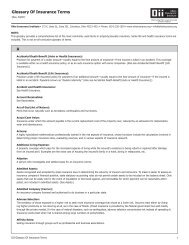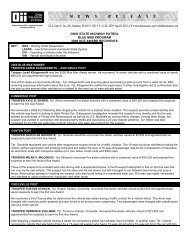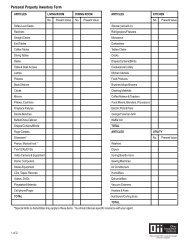Untitled - Ohio Insurance Institute
Untitled - Ohio Insurance Institute
Untitled - Ohio Insurance Institute
Create successful ePaper yourself
Turn your PDF publications into a flip-book with our unique Google optimized e-Paper software.
Tornadoes<br />
are dangerous<br />
A tornado’s strength is hard to imagine, but it can spin at speeds exceeding<br />
200 mph as it moves across land. Never try to outrun a tornado,<br />
since it can change direction in an instant. The best thing to do if a<br />
tornado is sighted is to seek safe shelter immediately.<br />
l HOW TORNADOES ARE FORMED<br />
Tornadoes form when cold, dry air meets with warm, moist air. A whirlwind<br />
is created by the gust of warm air rising in a spiral motion, causing<br />
water vapor to be swept upward. As the warm air cools, a twisting,<br />
spiral-shaped cloud forms. This funnel cloud is what we know as a<br />
tornado.<br />
Cold air whirls around the outside of the funnel, causing a roar that<br />
often sounds like a loud freight train. Air pressure inside the tornado is<br />
very low, as if there is a hole in the air. Outside, air spins into the hole<br />
carrying with it anything in its path. The tornado travels as it spins.<br />
A tornado usually lasts only minutes. Thunderstorms create the<br />
energy that feeds tornadoes. As the rain accompanying a tornado falls<br />
to earth, it cools the land. The tornado weakens as the steady supply of<br />
warm, moist, rising air dies out. The spinning motion slows down as the<br />
heated air is no longer pushed up, and is replaced by the cooler, heavier<br />
inflowing air.<br />
<strong>Ohio</strong> averages 16 tornadoes and five tornado-related fatalities each<br />
year.<br />
l TORNADO FACTS<br />
• <strong>Ohio</strong>’s tornado activity has been below average for the past few<br />
years. Four tornadoes were reported in 2005, causing no injuries or<br />
deaths. <strong>Ohio</strong>’s eight tornadoes in 2004 caused one injury and no<br />
deaths; while 12 tornadoes resulted in 18 injuries in 2003. <strong>Ohio</strong>’s<br />
tornado activity in 2002 was above average—22 tornadoes resulted<br />
in 16 injuries and five deaths. <strong>Ohio</strong>’s worst year for tornadoes was<br />
1992 when 60 tornadoes were confirmed. Texas holds the record for<br />
the greatest number—178 tornadoes occurred in the Lone Star state<br />
in 2004.<br />
NOTE: (Additional tornado statistics can be found online at www.<br />
weathersafety.ohio.gov.)<br />
• Tornadoes are usually accompanied by hail, severe thunderstorms<br />
and wind. <strong>Ohio</strong> experiences thunderstorm activity an average of<br />
30–50 days annually.<br />
• Severe Weather Awareness Week in <strong>Ohio</strong> is held annually, usually<br />
in March, to serve as a reminder to “brush up” on safety precautions<br />
prior to the height of severe weather season.<br />
• Most tornadoes occur during spring and summer months in the late<br />
afternoon on a hot day. Nationally, the peak months tend to be May,<br />
June and July. About one in every four tornadoes occurs between<br />
4–6 p.m. Peak season in <strong>Ohio</strong> is April through mid-July, with most<br />
occurring between 2–10 p.m. But, tornadoes can strike anywhere, at<br />
anytime of day or night. <strong>Ohio</strong> experienced damage-causing tornadoes<br />
in November 2002 and 2003.<br />
• A “waterspout” is a tornado over the water. Tornadoes are also<br />
known as cyclones, twisters and funnel clouds.<br />
• Over the 10-year period, 1996–2005, the US averaged 1,278 tornadoes<br />
and 58 tornado-related deaths per year. In the prior 10 years<br />
(1986–1995), the US averaged 1,003 tornadoes and 42 deaths per<br />
year. A record-breaker occurred in 2004 when 1,819 tornadoes<br />
touched down in the US, which caused 36 deaths.<br />
l POINTS TO COVER<br />
• How a tornado is formed<br />
• Why a tornado is dangerous<br />
• When <strong>Ohio</strong> tornadoes usually occur<br />
• The purpose of Severe Weather Awareness Week<br />
l ACTIVITIES<br />
1. Obtain two-2 liter pop bottles. Fill one with water. Connect the tops<br />
of the bottles, using a washer and duct tape, or purchase a “Tornado<br />
Tube” from a science or teacher supply store or online. Tip the full<br />
bottle upside down and swirl the water to drain into the empty<br />
bottle. The result depicts how a tornado forms.<br />
2. Fill a mayonnaise or mason jar with water. Make the water swirl by<br />
stirring it with a spoon. Drop in a few drops of food coloring or ink.<br />
Another way to make a tornado in a bottle is to mix water, food<br />
coloring and a few drops of liquid soap in a quart jar. Tightly cap the<br />
jar. Give the jar a quick twist with both hands and watch the vortex<br />
appear in the jar.<br />
3. To depict a tornado’s force: Get a potato and a plastic drinking straw.<br />
Hold the straw against the potato, and apply pressure (more than<br />
likely the straw will bend and not penetrate the potato). Now, hold<br />
the potato in one hand, and the straw in the other about 2 feet apart.<br />
Thrust the straw into the potato (it should penetrate depicting the<br />
force of wind). The greater the velocity of matter, the greater its momentum.<br />
The faster you make the straw move, the greater its force<br />
when it strikes the potato and the deeper it will penetrate. The force<br />
of a tornado has been known to drive straws right through boards!<br />
4. Additional activity resources<br />
• Scholastic http://teacher.scholastic.com/activities/wwatch/<br />
tornadoes/experiments.htm<br />
• Weather Wiz Kids (includes other types of weather experiments<br />
too) http://www.weatherwizkids.com/WxExperiments.htm<br />
• National Geographic Kids http://www.nationalgeographic.com/<br />
ngkids/trythis/trythis_water/bottled-vortex.html<br />
• <strong>Ohio</strong> EMA Disaster Detectives http://www.ema.ohio.gov/kids_<br />
page/index.htm<br />
be prepared<br />
It’s important that students know the difference between a tornado<br />
“watch” and “warning.”<br />
• A Tornado WATCH means a tornado could occur—the climatic conditions<br />
are right for a tornado. When a watch is issued, be prepared<br />
to seek shelter and stay tuned to the radio or television for weather<br />
updates. Or, listen to the National Weather Service updates on a<br />
weather radio.<br />
• A Tornado WARNING is your signal to SEEK SHELTER IMMEDIATELY<br />
—this means a tornado has been sighted in the area. The National<br />
Weather Service, which tracks storms on radar, will issue a tornado<br />
WATCH or WARNING as needed. Whenever there is danger of a tornado,<br />
it’s very important that you are prepared to act quickly. Some<br />
communities have special sirens to warn of an approaching tornado.<br />
Radio and television stations will broadcast information about severe<br />
weather through special weather bulletins and newscasts.<br />
Encourage your students to participate in the <strong>Ohio</strong> Committee for Severe Weather Awareness Annual Poster Contest<br />
Download details & entry requirements at www.weathersafety.ohio.gov<br />
2









